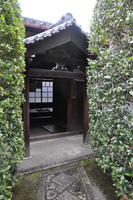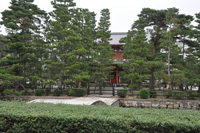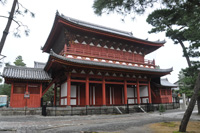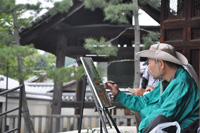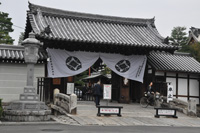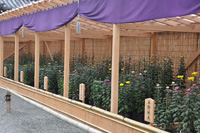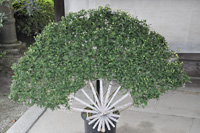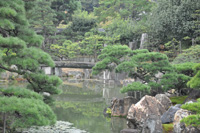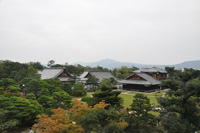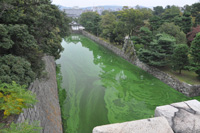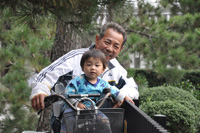 Myōshin-ji temple complex in Kyoto is home to the Rinzai Zen school of Buddhism. This sect contains within it more than three thousand temples throughout Japan, along with nineteen monasteries, but this is the largest school of Rinzai Zen. Nearly all of the buildings were destroyed in the Ōnin War in 1467; however, many of them have been rebuilt.
Myōshin-ji temple complex in Kyoto is home to the Rinzai Zen school of Buddhism. This sect contains within it more than three thousand temples throughout Japan, along with nineteen monasteries, but this is the largest school of Rinzai Zen. Nearly all of the buildings were destroyed in the Ōnin War in 1467; however, many of them have been rebuilt.
A difference between this and other schools of Rinzai Zen is that the Myōshin-ji school does not necessarily follow the set of established koan (a story, dialogue, question, or statement, the meaning of which cannot be understood by rational thinking but may be accessible through intuition) for the sake of testing one's stage of enlightenment. Rather the Myōshin-ji school allows the master to specifically tailor koan to a student's needs and background. This method diverges from the traditionally accepted canon of koan.
 Rinzai Zen in Japan today is not a single organized body. Rather, it is divided into 15 branches, referred to by the names of their head temples. The largest and most influential of these is the Myoshin-ji branch, whose head temple was founded in 1342 by Kanzan Egen Zenji (1277–1360). The time during which Rinzai Zen was established in Japan also saw the rise of the samurai to power. Along with early imperial support, Rinzai came to enjoy the patronage of this newly ascendant warrior class; as the Rinzai style of Zen practice may be characterized as somewhat martial or sharp (following in the spirit of Linji Yixuan), this is perhaps not surprising. In this regard, Rinzai is often contrasted with another sect of Zen deeply established in Japan, Sōtō, which has been called more gentle and even rustic in spirit. A Japanese saying reflects these perceptions: "Rinzai for the Shōgun, Sōtō for the peasants" (Rinzai Shōgun, Sōtō Domin).
Rinzai Zen in Japan today is not a single organized body. Rather, it is divided into 15 branches, referred to by the names of their head temples. The largest and most influential of these is the Myoshin-ji branch, whose head temple was founded in 1342 by Kanzan Egen Zenji (1277–1360). The time during which Rinzai Zen was established in Japan also saw the rise of the samurai to power. Along with early imperial support, Rinzai came to enjoy the patronage of this newly ascendant warrior class; as the Rinzai style of Zen practice may be characterized as somewhat martial or sharp (following in the spirit of Linji Yixuan), this is perhaps not surprising. In this regard, Rinzai is often contrasted with another sect of Zen deeply established in Japan, Sōtō, which has been called more gentle and even rustic in spirit. A Japanese saying reflects these perceptions: "Rinzai for the Shōgun, Sōtō for the peasants" (Rinzai Shōgun, Sōtō Domin).
 In 1601, Tokugawa Ieyasu, the founder of the Tokugawa Shogunate, ordered all the feudal lords in Western Japan to contribute to the construction of Nijō Castle, which was completed during the reign of Tokugawa Iemitsu in 1626. It was built as the Kyoto residence of the Tokugawa Shoguns. The Tokugawa Shogunate used Edo as the capital city, but Kyoto continued to be the home of the Imperial Court. Kyoto Imperial Palace is located north-east of Nijo Castle. In 1867, the Ninomaru Palace was the stage for the declaration by Tokugawa Yoshinobu, returning the authority to the Imperial Court. Next year the Imperial Cabinet was installed in the castle. The palace became imperial property and was declared a detached palace. During this time, the Tokugawa hollyhock crest was removed wherever possible and replaced with the imperial chrysanthemum. In 1939, the palace was donated to the city of Kyoto and opened to the public the following year.
In 1601, Tokugawa Ieyasu, the founder of the Tokugawa Shogunate, ordered all the feudal lords in Western Japan to contribute to the construction of Nijō Castle, which was completed during the reign of Tokugawa Iemitsu in 1626. It was built as the Kyoto residence of the Tokugawa Shoguns. The Tokugawa Shogunate used Edo as the capital city, but Kyoto continued to be the home of the Imperial Court. Kyoto Imperial Palace is located north-east of Nijo Castle. In 1867, the Ninomaru Palace was the stage for the declaration by Tokugawa Yoshinobu, returning the authority to the Imperial Court. Next year the Imperial Cabinet was installed in the castle. The palace became imperial property and was declared a detached palace. During this time, the Tokugawa hollyhock crest was removed wherever possible and replaced with the imperial chrysanthemum. In 1939, the palace was donated to the city of Kyoto and opened to the public the following year.
I arrived in Kyoto on a rainy day and with the knowledge that I only had a day and an overnight to explore this important city. The simplicity of Myoshinji complex was matched by an overcast day which, together, were disconcerting. One of the attractions to Zen is the simplicity it engenders through a moral forcefulness. I don't mind looking inward, especially when I'm ready to do so. The shukubo was the simplest and there were only two of us staying there. My boredom (it was too quiet and the place was in an isolated neighborhood) forced me out of the complex into the city. But I would have to return.
 The pictures on this page do not capture the vibrancy or energy of Kyoto but, instead, its more orderly aspects. Kyoto is known for its rituals and societal conventions. There has been a lot written about its tea ceremonies, gardens, and elite classes. It is also a thoroughly modern city, as much so as any I've seen. I will save a more thorough exploration of this city for another time, and as time unfolds I would say that will be more likely.
The pictures on this page do not capture the vibrancy or energy of Kyoto but, instead, its more orderly aspects. Kyoto is known for its rituals and societal conventions. There has been a lot written about its tea ceremonies, gardens, and elite classes. It is also a thoroughly modern city, as much so as any I've seen. I will save a more thorough exploration of this city for another time, and as time unfolds I would say that will be more likely.
But most of all, I think I missed out on an opportunity to see another face of Japanese Buddhism with more detail. At this point I had four days straight of temples and, here, may have given one of the most important ones short shrift.
I went out for a long walk at night in search of dinner and stumbled upon a pretty ordinary looking place where I had the best meal of the trip. The cook sat me at a bar where he prepared everything to order. I was able to convey that I was leaving the entire meal up to him. I watched as he cooked the meal: batter for some-sort-of tentacles tempura, a heap of julienned vegetables with soy dressing, and the standard pickled vegetables and rice. The young cook and his wife appeared to be happy with my enjoyment of the meal: there was a lot of bowing.
When I returned to the temple complex it was pretty late but I was able to walk around a good bit. The weather had finally cleared and it was late enough that most people had left the temple precincts. There were a few monks and people from the neighborhood jogging, but what was unusual was how dark it was. This was a neighborhood in Kyoto, but so many subtemples and shukubo had grown up over the centuries, and all of it was surrounded by a wall. In fact, most of the buildings in the complex had their own walls, which had the effect of creating a maze. It was a long walk because of the size of the place, and it was soothing to hear muffled gongs and chanting from within buildings.
